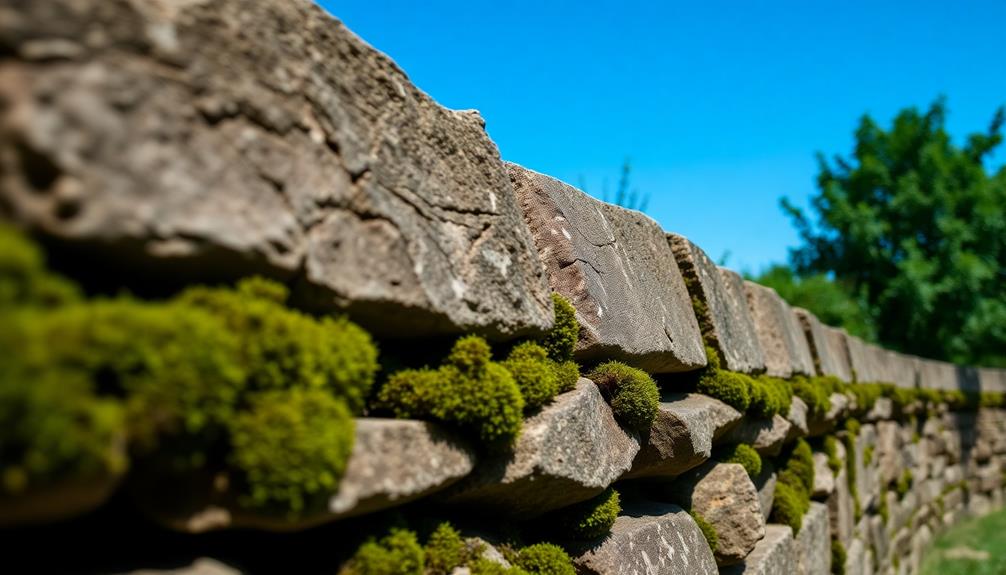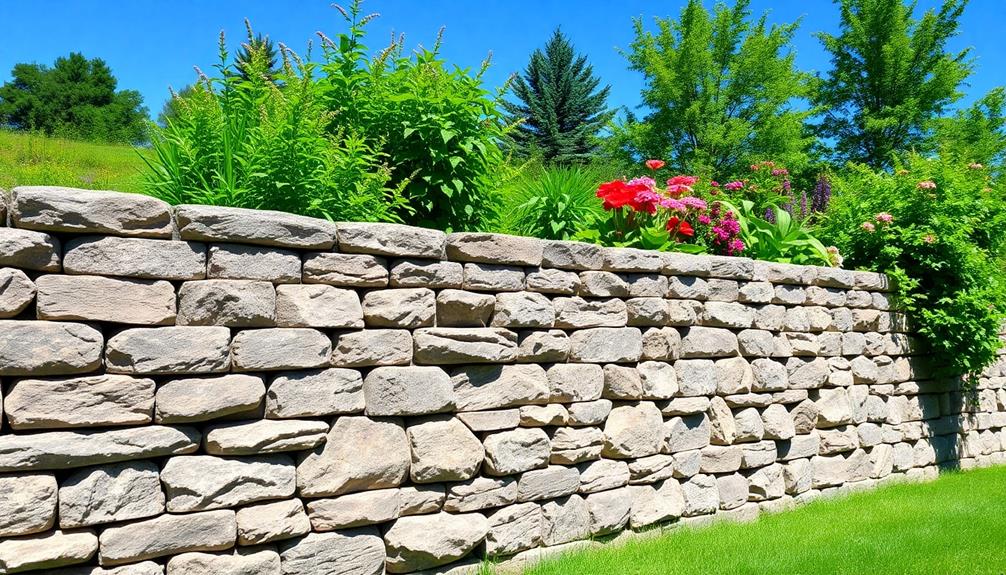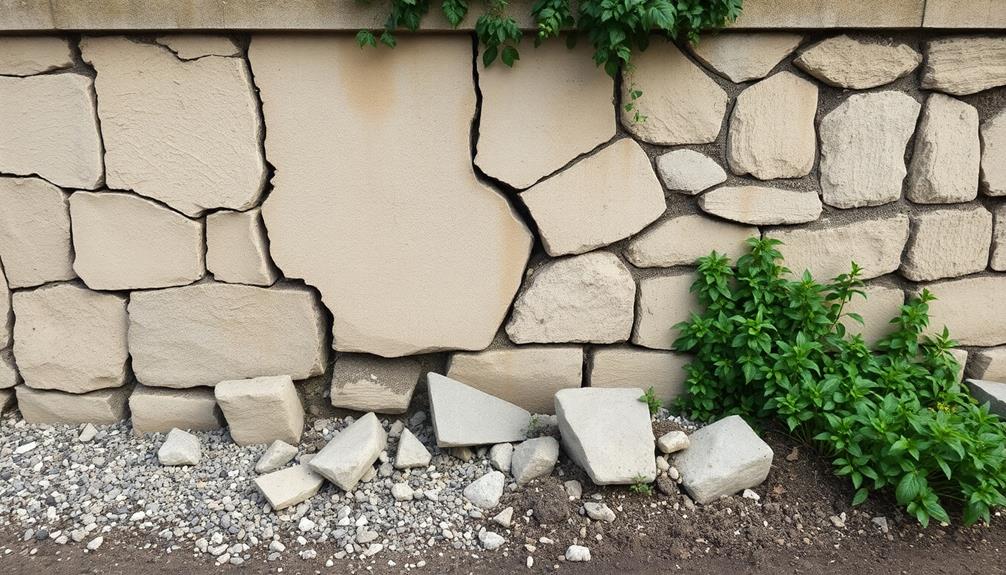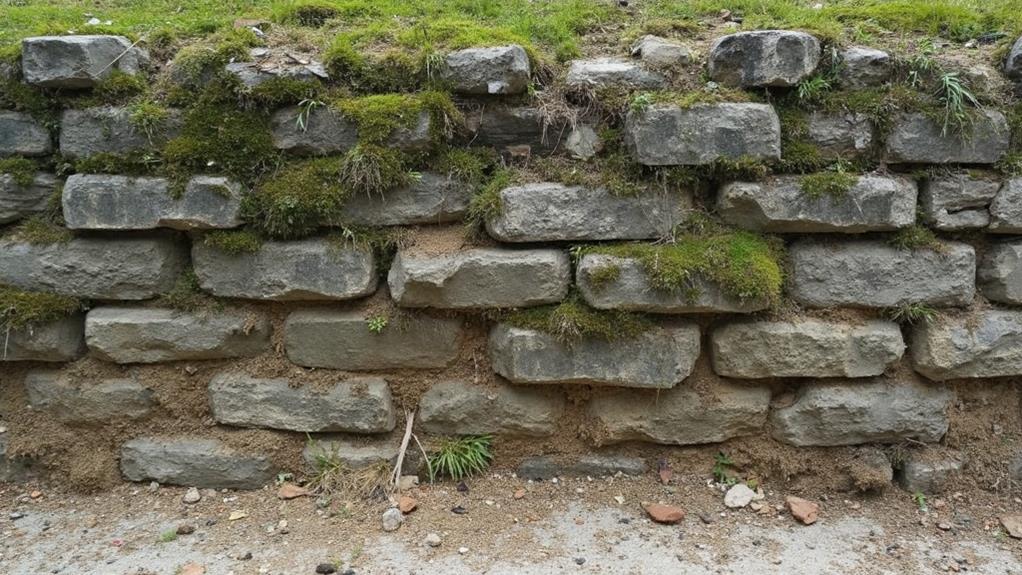Retaining walls are essential for stabilizing soil and preventing erosion, yet over time, they may exhibit signs that necessitate urgent repair. Key indicators include visible cracks which can compromise the structure's integrity, and tilting or leaning, suggesting foundational issues. Water drainage problems, such as excessive moisture seepage or pooling, highlight the need for improved water management systems. Gaps between the wall and soil, uneven settlement of adjacent ground, and intrusive vegetation further signal structural vulnerabilities. Addressing these signs promptly prevents further damage and guarantees the wall's continued effectiveness. Explore the multifaceted approaches to safeguarding and restoring your retaining wall.
Table of Contents
ToggleWalls Contractor Highlights
- Large visible cracks or gaps indicate significant structural issues in the retaining wall.
- Excessive water buildup or moisture stains suggest drainage problems needing repair.
- Tilting, leaning, or bowing of the wall is a sign of instability.
- Presence of deep-rooted vegetation can compromise the wall's structural integrity.
- Uneven settlement of the wall or adjacent ground points to foundational issues.
Definition of Retaining Wall

A retaining wall is a structural element designed to restrain soil at different elevations, providing critical support and stability to landscapes by preventing erosion and managing water runoff. These walls come in various types and materials, including concrete, stone, timber, and reinforced earth, each tailored to specific functional requirements and aesthetic preferences.
The construction and design of retaining walls necessitate careful consideration of load-bearing capabilities, effective drainage systems, and environmental factors to guarantee long-term durability and effectiveness. Boulder retaining walls, for example, offer a durable and cost-effective solution with their natural beauty and unique appearance, making them an alluring choice for both functional and visual purposes in landscaping.
Purpose and Functionality
Serving as essential structural elements, retaining walls are engineered constructions designed to hold back soil or rock from a building, structure, or area. They provide vital support, preventing erosion and managing the landscape to create usable, level areas in environments where the natural slope would otherwise be unsuitable for development.
The functionality of retaining walls extends beyond mere practicality, as they also contribute to the aesthetic and structural integrity of a property, fostering a sense of harmony and stability.
The primary purposes of retaining walls include:
- Erosion Control: Retaining walls act as barriers that prevent soil from washing away, thereby protecting the landscape from degradation.
- Structural Support: They provide indispensable support for vertical or near-vertical changes in landscape elevation, ensuring the safety and stability of nearby structures.
- Landscaping Enhancement: Retaining walls can create tiered landscapes, allowing for creative gardening and landscaping opportunities that enhance the beauty and functionality of outdoor spaces.
Understanding the purpose and functionality of retaining walls helps property owners appreciate their contribution to both the utility and aesthetics of their environment, fostering a deeper connection to their surroundings and ensuring informed decisions regarding maintenance and repair.
Types and Materials
Retaining walls come in various types, each uniquely designed to address specific landscape challenges and requirements. These structures are essential in managing soil stabilization, preventing erosion, and creating usable flat areas on a sloped terrain. The selection of a retaining wall type depends heavily on the site conditions, desired aesthetic, and structural requirements.
Common types of retaining walls include gravity walls, which rely on their substantial mass to resist lateral earth pressure, and cantilever walls, often constructed from reinforced concrete, using a thinner stem and a base slab to provide stability. Sheet piling walls, typically made from steel, vinyl, or wood planks, are ideal for areas with limited space or soft soil conditions. Additionally, anchored walls utilize cables or other supports anchored into the rock or soil behind them, providing enhanced strength and fortification.
Materials used in constructing retaining walls vary widely, encompassing natural stone, concrete blocks, timber, and brick. Each material offers distinct aesthetic and functional benefits, influencing the wall's durability, cost, and maintenance needs. Selecting the right combination of type and material guarantees the retaining wall meets both practical and visual goals, contributing to a harmonious and functional landscape.
Construction and Design
The essence of retaining wall construction lies in its ability to provide structural support and stability to landscapes with varying elevations. These walls, meticulously designed and strategically constructed, serve as critical barriers that prevent soil erosion, manage water drainage, and create usable land on uneven terrain. The integrity of a retaining wall is essential, as it must withstand lateral pressure exerted by the soil it retains, ensuring the safety and aesthetics of the surrounding environment.
In understanding retaining wall construction and design, several key elements should be considered:
- Materials Selection: The choice of materials, such as concrete, stone, or timber, greatly impacts the wall's durability and aesthetic appeal, each offering distinct advantages tailored to specific environmental conditions and design preferences.
- Structural Engineering: Engineering principles guide the design, ensuring that the wall can support the anticipated load and environmental factors, such as water drainage and freeze-thaw cycles, which are critical to long-term performance.
- Aesthetic Integration: Beyond functionality, the design must harmonize with the landscape and existing structures, creating a cohesive and visually pleasing environment for property owners and visitors alike.
Benefits

Repairing retaining walls offers significant advantages, including enhanced structural stability, which is essential for maintaining the integrity of surrounding landscapes and infrastructure. Such repairs not only increase the property's value by guaranteeing long-lasting durability but also effectively prevent soil erosion, safeguarding the environment and reducing maintenance costs.
With expertise in fixing and maintaining concrete and stone retaining walls, these repairs assure structural integrity and safety. Additionally, a well-maintained retaining wall contributes to the aesthetic appeal of the property, creating a visually pleasing and functional outdoor space.
Enhanced Structural Stability
Achieving enhanced structural stability in retaining walls offers numerous benefits that extend beyond mere functionality. This foundational aspect guarantees that the walls can withstand the test of time, safeguarding your property from potential erosion and soil displacement. A structurally sound retaining wall not only serves as a robust barrier but also contributes to the harmonious integration of the landscape with your home, fostering a sense of unity and belonging within your environment.
The benefits of enhanced structural stability in retaining walls include:
- Longevity and Durability: A well-constructed retaining wall resists weathering and environmental pressures, extending its lifespan and reducing the need for frequent repairs.
- Safety and Security: Enhanced stability minimizes the risk of collapse, verifying both the safety of the property and its inhabitants, thereby providing peace of mind.
- Aesthetic Cohesion: A stable retaining wall maintains its form and function, preserving the aesthetic appeal of the landscape which is essential for creating a welcoming atmosphere.
Increased Property Value
Value is considerably enhanced when a property features well-maintained and structurally sound retaining walls. Such walls not only contribute to the aesthetic appeal of the landscape but also signify a commitment to maintaining the property's integrity. Potential buyers often perceive these elements as indicators of a well-cared-for home, which can positively impact their purchasing decisions.
A robust retaining wall showcases the homeowner's attention to detail and proactive measures in safeguarding their outdoor spaces, thereby fostering a sense of confidence and trust in prospective buyers.
Moreover, a structurally sound retaining wall can be seen as an asset that adds functional utility to a property. It can create level areas for additional landscaping, gardening, or recreational activities, making the property more attractive and versatile. The enhanced usability of the outdoor space can increase the property's marketability, potentially leading to a higher selling price.
Additionally, in areas where terrain management is essential, having reliable retaining walls can be a significant advantage, appealing to buyers who value strategic land use and sustainability. In other words, investing in the upkeep of retaining walls not only preserves but can also elevate a property's market value, ensuring it stands out in competitive real estate markets.
Prevents Soil Erosion
A well-designed retaining wall serves as a critical barrier against soil erosion, protecting both the landscape and the structural integrity of a property. By firmly anchoring the soil, these walls prevent the displacement and degradation that can occur due to water runoff or adverse weather conditions. This protection not only maintains the aesthetic and functional aspects of a property but also upholds its long-term value.
The retention of soil is crucial in preserving the ecosystem and the hard work invested in landscaping, ensuring that properties remain both beautiful and structurally sound.
Retaining walls offer numerous benefits, which include:
- Stability for Sloped Areas: They provide essential support to sloped landscapes, preventing landslides and soil movement that could otherwise compromise property safety.
- Protection of Infrastructure: By preventing soil erosion, retaining walls safeguard nearby structures such as buildings, roads, and pathways from potential damage.
- Environmental Conservation: By controlling soil erosion, these walls contribute to the protection of the surrounding environment, minimizing the impact on local flora and fauna.
Understanding these advantages underscores the significance of maintaining a well-functioning retaining wall, ensuring it remains an effective protector against the forces of nature.
Improves Aesthetic Appeal
Retaining walls not only serve functional purposes but also tremendously enhance the visual appeal of a property. When designed and maintained properly, these structures can transform an ordinary outdoor space into an attractive, cohesive landscape.
A well-maintained retaining wall seamlessly integrates with the existing architecture and natural surroundings, adding a layer of sophistication and order. For property owners who take pride in their homes, a visually appealing retaining wall offers a sense of belonging to the aesthetic harmony of their neighborhood.
Moreover, diverse materials such as natural stone, brick, or textured concrete allow for customization that reflects personal style and complements the property's overall theme. The choice of materials, colors, and textures can either make a bold statement or gently blend into the landscape, offering flexibility in design to suit different tastes and preferences.
Over time, however, exposure to the elements can lead to wear and tear, diminishing the wall's aesthetic value. Regular inspections and timely repairs guarantee that the retaining wall continues to enhance the property's charm. This attention to detail not only preserves the wall's functionality but also maintains its role as a key visual feature in the landscape.
Common Repair Warning Signs

In any retaining wall system, early identification of repair warning signs is vital to prevent further structural deterioration and potential safety hazards. Common indicators such as cracks and bulging walls, water drainage issues, and a leaning or tilting structure can signal the need for immediate attention to maintain the wall's integrity and functionality. The following table outlines these warning signs and their implications:
| Warning Sign | Potential Cause | Consequence |
|---|---|---|
| Cracks and Bulging | Soil pressure, material wear | Structural failure risk |
| Water Drainage Issues | Clogged drains, poor design | Water retention, wall erosion |
| Leaning or Tilting | Foundation shifts, load stress | Compromised stability and safety |
Cracks and Bulging Walls
Cracks and bulging walls serve as significant indicators of potential structural issues in retaining walls, demanding prompt attention and repair. These manifestations are often symptomatic of underlying problems such as soil pressure, improper construction, or the natural wear and tear over time. When left unaddressed, they can escalate, potentially leading to more severe damage, compromising the integrity and safety of the wall. Observing these signs early can prevent further deterioration and maintain the longevity of your retaining wall.
The presence of cracks and bulges in retaining walls can be attributed to several factors, including:
- Soil Movement: Expansion and contraction of the soil can exert undue pressure on the wall, causing it to crack or bulge.
- Poor Construction: Inadequate materials or design flaws during the construction phase can lead to structural weaknesses.
- Tree Roots: The growth of nearby tree roots can push against the wall, leading to bulging or cracking.
For those who value the stability and safety of their outdoor spaces, recognizing and addressing these signs is essential. A sense of community and pride in one's environment is fostered when preventative measures are taken, maintaining the structural integrity of shared spaces.
Water Drainage Issues
Effective water drainage is indispensable for the stability and longevity of retaining walls, as improper drainage can lead to significant structural problems. When water accumulates behind a retaining wall, it increases the hydrostatic pressure exerted on the structure, potentially causing damage over time. This pressure can exacerbate existing vulnerabilities, leading to issues such as cracking, bulging, or even wall failure if not addressed promptly. Consequently, recognizing and rectifying water drainage issues is pivotal for maintaining the integrity of a retaining wall.
Indicators of water drainage problems often include visible water pooling at the base of the wall or soggy soil conditions in the surrounding area. Additionally, efflorescence, a white powdery substance that appears on the surface of masonry, can signify moisture infiltration. This phenomenon occurs when water dissolves salts within the wall, carrying them to the surface as the moisture evaporates. Identifying these signs early allows for timely intervention, which may involve installing or repairing drainage systems, such as weep holes or French drains, to effectively redirect water away from the wall. By ensuring proper drainage, you protect the structural soundness and aesthetic appeal of your retaining wall, fostering a sense of security and community within your property.
Leaning or Tilting Structure
Stability is paramount when evaluating the health of a retaining wall, and any signs of a leaning or tilting structure warrant immediate attention. Such deviations from the vertical plane often signal underlying issues that compromise the wall's integrity and functionality. These structural shifts might arise from various factors, including inadequate construction, soil erosion, or excessive water pressure. Addressing these problems promptly is essential to prevent further deterioration and potential failure, which could result in costly repairs and safety hazards for the surrounding environment.
To assess whether your retaining wall requires immediate repair, consider the following indicators:
- Visible Gaps: Observe for gaps between the wall and the soil it retains, suggesting movement away from its original position.
- Uneven Settlement: Look for uneven settling of adjacent ground or pavement, hinting at foundational instability.
- Cracking Patterns: Notice horizontal or stair-step cracking on the wall's surface, which typically accompanies leaning or tilting.
For community members, these signs serve not only as a call to action but as a reminder of the importance of proactive maintenance. Engaging with professional services guarantees a solution tailored to your retaining wall's specific requirements, fostering a sense of confidence and belonging within a well-preserved shared space.
Walls Contractor FAQ
How Often Should a Retaining Wall Be Inspected for Potential Issues?
Regular inspection of a retaining wall is essential for community safety and aesthetic preservation. It is recommended to conduct a thorough assessment at least annually, ensuring early detection of potential issues and fostering a sense of shared responsibility and care.
What Materials Are Commonly Used to Repair Retaining Walls?
Common materials for repairing retaining walls include concrete, steel reinforcements, and masonry units. These materials, when skillfully applied, guarantee structural integrity and longevity, fostering a sense of security and belonging within the built environment for communities and individuals alike.
Can DIY Repairs Be Effective for Minor Retaining Wall Damage?
DIY repairs can be effective for minor retaining wall damage, fostering a sense of accomplishment and community engagement. However, guarantee proper assessment and use of appropriate materials to maintain structural integrity and safeguard your investment in a lasting solution.
How Long Does a Typical Retaining Wall Repair Take to Complete?
The duration of a retaining wall repair varies based on the wall's condition, damage extent, and repair method. Typically, minor repairs might take a few days, while more extensive work could extend to several weeks, ensuring structural integrity.
Are There Specific Maintenance Tips to Prevent Retaining Wall Damage?
Maintaining a retaining wall involves regular inspections for cracks, ensuring proper drainage, and removing vegetation that exerts pressure. By fostering a proactive maintenance culture, communities can enhance structural longevity and prevent costly repairs, reinforcing a sense of collective responsibility.







